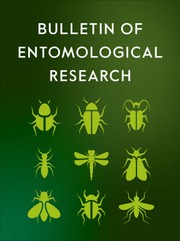No CrossRef data available.
Article contents
Transcriptomic insights into Smoothened-dependent modulation of olfactory receptor genes in Apis mellifera ligustica: Implications for olfactory signal processing
Published online by Cambridge University Press: 18 July 2025
Abstract
To investigate the effects of activating/inhibiting AmelSmo on the olfactory genes and signalling pathways of Apis mellifera ligustica, as well as the potential regulatory mechanisms involved. Transcriptomic sequencing was performed on Apis mellifera ligustica antennae using Illumina HiSeq platform following administration of cyclopamine (inhibitor) and purmorphamine (agonist). Differential gene expression analysis, coupled with GO and KEGG pathway annotations, facilitated the identification of olfactory receptor genes. The reliability of transcriptome data was subsequently validated through quantitative real–time–polymerase chain reaction analysis. Transcriptomic analysis revealed 12,356 differentially expressed genes (DEGs) between inhibitor and control groups, with 276 genes showing significant differential expression. Similarly, 12,356 DEGs were identified between the agonist and control groups, among which 672 genes exhibited significant differential expression. The GO annotation revealed that the DEGs in the inhibitor group and the agonist group were mainly enriched in the biological process such as cellular process, metabolic process, and biological regulation; in cellular component, enrichment was mainly observed in cell, cell part, and organelle; and in molecular function, the main enrichment was in binding and catalytic activity. KEGG pathway analysis indicated that DEGs from both groups were primarily enriched in signal transduction pathways. Among the DEGs, three olfactory receptor genes were identified in the inhibitor group: odorant receptor 19, odorant receptor 22, and odorant receptor 5. The agonist group exhibited two olfactory receptor genes: odorant receptor 109 and odorant receptor 26. All these olfactory receptor genes demonstrated downregulated expression patterns. Transcriptomic sequencing analysis identified five olfactory receptor genes. The changes in gene expression levels suggest that the activation or inhibition of AmelSmo may regulate the expression of olfactory receptors via the Hedgehog signalling pathway. It is speculated that AmelSmo may play a regulatory role in the olfactory system of bees.
Information
- Type
- Research Paper
- Information
- Copyright
- © The Author(s), 2025. Published by Cambridge University Press.
Footnotes
These authors have contributed equally to this work


